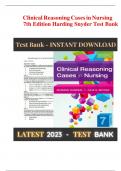Exam (elaborations)
Clinical Reasoning Cases in Nursing 7th Edition Harding Snyder Test Bank (Contains All chapters, Newly updated
Clinical Reasoning Cases in Nursing 7th Edition Harding Snyder Test Bank (Contains All chapters, Newly updated
[Show more]



